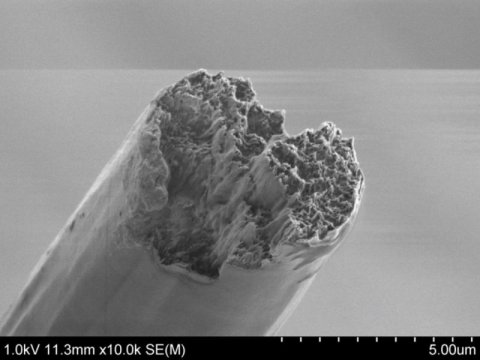A way to artificially assemble nanocellulose (particles) from wood to make biomimetic materials that surpass the strength of any recorded bio-based substance, even spider silk has been developed by researchers from the KTH Royal Institute of Technology Sweden and their colleagues in Germany and the USA. N Mittal et al., ACS Nano, 2018; DOI: 10.1021/acsnano.8b01084.
"It was believed in the scientific community for long that spider silk is the strongest bio-based material ever known," says team member Nitesh Mittal. "Now we have created a material which is even stronger." He adds that the specific strength of their material is also much higher than any known metal, alloy or glass fibers. Mittal adds that the finding will "boost confidence in environment friendly materials compared to petroleum-based ones."
Although technology has in recent advanced years advanced rapidly in many areas, researchers continue to struggle in making novel materials and biomimetic materials that might outperform their natural counterparts. After all, nature has had millions of years to refine its materials through evolution, whereas humanity has a few thousand years and until recently only a very limited number of ways to manipulate atoms. However, materials scientists are taking steps towards emulating the structures and architectures of natural materials at the nanoscale level. Strength is one perennially important property in seeking biomimetic materials manipulating structure at the nanoscale will hopefully translate into novel bulk properties such as large-scale strength.
The team already knew how strong the stiff plant cells in wood can be. The cell walls comprise cellulose nanofibrils (CNFs) and it is their hierarchical organization that makes wood strong and is serving as inspiration for the creation of strong, macroscale substances. However, poor adhesion and un-aligned components have so far precluded the development of an artificial wood. The team has now sought to overcome these limitations by using flow-assisted assembly to organize CNFs into a near-perfect alignment within macroscale fibers.
They explain that even the weakest fiber they fabricated using their approach was stronger than other CNF fibers previously reported. Most importantly, the macroscale fibers were stronger than metal, alloys and glass fibers. And they are both stronger and eight times stiffer than dragline spider silk, which is the gold standard for lightweight biopolymers, at the same specific strength.
The team suggests that this new material might be useful in many load-bearing applications, such as light-weight bio-based composites for cars and bikes, as well as high-performance medical implants.
Story Source
Materials Today (https://www.materialstoday.com/biomaterials/news/outstripping-spider-silk-with-cellulose/)
Reference
- Nitesh Mittal, Farhan Ansari, KrishneGowda.V, Christophe Brouzet, Pan Chen, Per Tomas Larsson, Stephan V. Roth, Fredrik Lundell, Lars Wågberg, Nicholas A. Kotov, and L. Daniel Söderberg. Multiscale Control of Nanocellulose Assembly: Transferring Remarkable Nanoscale Fibril Mechanics to Macroscale Fibers. ACS Nano, 2018 DOI: 10.1021/acsnano.8b01084
